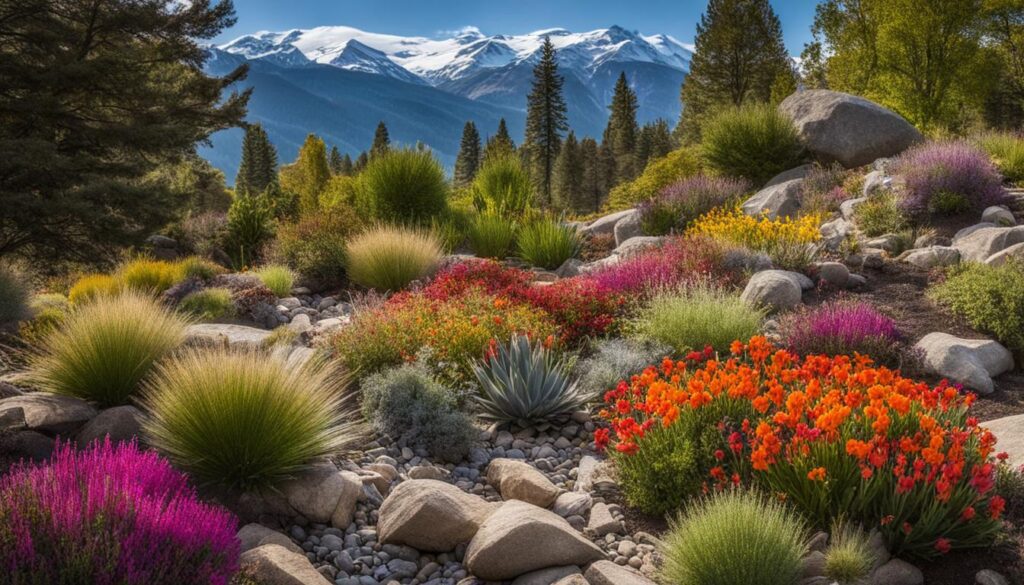Creating a thriving garden in cold regions can be challenging, especially with extreme temperatures and limited water resources. However, with the practice of xeriscape gardening, you can create a beautiful and sustainable water-wise garden even in harsh winters. Xeriscape care in cold regions involves selecting native plants, proper drainage, and grouping water-wise plants to ensure the success of your xeriscaping journey.
Key Takeaways:
- Implementing xeriscape care techniques is essential for maintaining a water-wise garden in cold regions.
- Native plants are well-adapted to local weather conditions and require less water, making them ideal for xeriscape gardens in cold regions.
- Understanding the challenges of winter gardening in cold regions, such as extreme cold and limited rainfall, is crucial for successful xeriscape care.
- Proper drainage and soil improvement techniques help prevent waterlogging and ensure the survival of xeriscape plants in cold regions.
- By following the steps for implementing a xeriscape garden and practicing ongoing maintenance, you can enjoy the benefits of a low-maintenance and environmentally friendly landscape in cold regions.
Understanding Winter Gardening Challenges
Winter gardening in cold regions presents unique challenges due to extreme cold temperatures, dry conditions, limited rainfall, and the resulting stress on plants. These factors can take a toll on the health and vitality of your xeriscape garden. However, with careful planning and proper care, you can overcome these challenges and create a thriving winter garden.
Extreme Cold: The frigid winter temperatures can be harsh on plants, especially those not adapted to cold climates. It is essential to select cold-hardy plants that can withstand freezing temperatures and still flourish.
Dry Conditions and Limited Rainfall: During winter, there is often a lack of moisture due to limited rainfall and dry air. This poses a particular challenge for xeriscape gardens that rely on water conservation. Choosing drought-tolerant plants and implementing efficient watering techniques are vital to ensure your plants’ survival.
Stress to Plants: Winter stress can weaken plants and make them susceptible to diseases and pests. It is crucial to provide proper care and protection to minimize stress factors. Adequate mulching, proper irrigation, and sheltering tender plants can help alleviate stress and promote healthier growth.
Quote: “Winter gardening requires careful consideration of the unique challenges posed by cold regions. By selecting cold-hardy plants and implementing efficient watering and protection measures, you can create a vibrant xeriscape garden that thrives even in extreme winter conditions.”
Soil Type and Drainage
When planning your winter xeriscape garden, consider the soil type and drainage in your region. Well-draining soil is crucial to prevent waterlogging and root rot, especially during periods of heavy rainfall or melting snow. If your soil is heavy in clay, consider amending it with organic matter such as compost or peat moss to improve drainage.
Winter Protection
Protecting your plants from winter elements is essential for their survival. Consider using protective covers, such as burlap or frost blankets, for delicate or vulnerable plants. Adding a layer of organic mulch around the base of plants can also provide insulation and help regulate soil temperature.
- Choose cold-hardy plants that can withstand freezing temperatures.
- Select drought-tolerant plants that can thrive in dry conditions.
- Implement proper mulching and irrigation techniques to minimize stress on plants.
- Consider soil type and drainage to ensure proper water flow and prevent waterlogging.
- Provide winter protection for vulnerable plants using covers and organic mulch.
By understanding and addressing the challenges of winter gardening in cold regions, you can create a successful xeriscape garden that not only survives but thrives in the harshest of winter conditions.
The Role of Native Plants in Xeriscape Gardens
Native plants play a crucial role in the success of xeriscape gardens in cold regions. These plants are specifically adapted to the local weather conditions, making them well-suited for conserving water and thriving in harsh winters. By incorporating native plants into your xeriscape garden, you not only create a beautiful landscape but also provide essential benefits to the ecosystem.
One of the key advantages of using native plants is their water-wise nature. These plants have evolved to require less water, making them highly efficient in conserving this precious resource. By reducing the need for additional watering, native plants help to minimize water usage and ensure the sustainability of your xeriscape garden.
Furthermore, native plants support local wildlife by providing essential shelter and food sources. They attract bees, butterflies, birds, and other beneficial insects, creating a vibrant ecosystem within your garden. By incorporating a variety of native plants, you can help to support biodiversity and promote the health of the local wildlife population.
Another important advantage of native plants in xeriscape gardens is their ability to protect against wildfires. Many native plants have fire-resistant properties, making them a valuable choice for regions prone to wildfires. These plants can help create a buffer zone around your property, reducing the risk of fire spreading and protecting your home and landscape.
Incorporating native plants into your xeriscape garden not only enhances its beauty but also ensures a more sustainable and resilient landscape. By conserving water, providing habitat for wildlife, and offering protection against wildfires, native plants are an indispensable part of creating a successful and environmentally-friendly xeriscape garden in cold regions.
Hydrozoning for Winter Water Conservation
When it comes to xeriscape gardening in cold regions, water conservation is crucial. One effective technique for conserving water in your winter xeriscape garden is hydrozoning. Hydrozoning involves grouping plants together based on their specific water needs and sunlight requirements. By implementing hydrozoning in your garden, you can maximize water usage and ensure that each plant receives the appropriate amount of water.
During the winter months, it is important to select plants that can retain moisture for longer periods of time. Look for plants with thick leaves and fine hairs, as they are better equipped to hold onto moisture. These plants have adapted to survive in dry conditions and are ideal for xeriscape gardens in cold regions. By strategically placing these water-wise plants in your garden, you can minimize water loss and promote efficient water usage.
Hydrozoning also allows you to create different water zones within your garden. For example, you can group plants with high water needs together in one zone, while grouping plants with lower water needs in another zone. This way, you can irrigate each zone separately based on their specific requirements. This not only helps conserve water but also ensures that plants receive the right amount of moisture, promoting healthy growth and reducing the risk of overwatering or underwatering.
Benefits of Hydrozoning:
- Maximized water usage.
- Efficient moisture retention in plants.
- Promotes healthy growth and reduces risk of overwatering or underwatering.
- Conserves water by irrigating each zone separately based on specific requirements.
Implementing hydrozoning techniques in your winter xeriscape garden can greatly benefit your water conservation efforts. By carefully considering the water needs and sunlight requirements of your plants, along with grouping them appropriately, you can create a sustainable and thriving garden even in cold regions. Take advantage of hydrozoning and make the most out of your water-wise plants to create a beautiful and eco-friendly winter xeriscape garden.
Managing Proper Drainage in Xeriscape Gardens
In xeriscape gardening, proper drainage is crucial for the health and success of your garden, especially in cold regions. The rocky environments typically found in these areas can pose challenges, but with the right techniques, you can ensure that excess water doesn’t become a problem.
To improve drainage in your xeriscape garden, it’s important to focus on the soil composition. Adding organic matter, such as compost or well-rotted manure, can help improve the soil structure and increase its ability to drain water efficiently. This is particularly important if you have clay soil, which tends to retain water and can cause root rot in xeric plants.
One effective method for managing drainage is to create raised mounds or berms in your xeriscape garden. By elevating the planting area, you allow excess water to flow away from plant roots, preventing waterlogging. Additionally, mulching your garden with organic materials such as wood chips or straw can help regulate moisture levels and improve nutrient penetration.
Remember, xeriscape plants are adapted to withstand dry conditions, so it’s essential to strike a balance between providing adequate drainage and avoiding excessive watering. By employing these techniques, you can ensure that your xeriscape garden thrives in even the rockiest of environments, creating a sustainable and visually appealing landscape.
Are the Xeriscape Care Tips for Cold Regions Different from Regular Xeriscape Care Tips?
Yes, xeriscape care tips for cold regions differ from regular xeriscape care tips. Homeowners in colder climates should focus on winterizing their xeriscapes by mulching, protecting plants, and minimizing watering. It’s important to understand the unique needs of xeriscapes in colder regions to ensure their survival and health.
Steps for Implementing a Xeriscape Garden in Cold Regions
Creating a xeriscape garden in cold regions requires careful planning and attention to various factors. By following these steps, you can establish and maintain a thriving and water-wise landscape in your area.
- Start with proper planning: Before diving into the implementation, take the time to plan your xeriscape garden. Consider the layout, size, and shape of your yard, as well as the specific areas where you want to incorporate water-wise plants. Determine the level of sunlight exposure, wind patterns, and any existing landscaping elements that you want to preserve or remove. This planning stage will help you make informed decisions throughout the process.
- Zoning of plants based on their needs: Divide your garden into zones based on the water and sunlight requirements of the plants you choose. Grouping plants with similar needs will help you efficiently manage irrigation and ensure optimal growth. For example, plants that require more water can be clustered closer to a water source, while those that prefer drier conditions can be placed in a separate zone.
- Improve the soil: Prepare your soil by adding organic matter, such as compost or well-rotted manure, to enhance its structure and moisture retention capabilities. Consider conducting a soil test to determine any specific nutrient deficiencies and adjust accordingly. Well-prepared soil will provide a solid foundation for your xeriscape garden to thrive.
- Choose efficient irrigation methods: Opt for irrigation techniques that minimize water wastage and ensure targeted watering. Drip irrigation or soaker hoses are ideal for delivering water directly to the root zone, reducing evaporation and runoff. Consider installing a rainwater collection system to further conserve water resources and supplement your irrigation needs.
- Select the right turf or alternatives: If you desire a traditional lawn in your xeriscape garden, choose a turf variety that is drought-tolerant and well-suited for your region’s climate. However, consider alternatives to turf such as native groundcovers, gravel, or mulch for areas where grass may not be necessary. These alternatives require less water and maintenance while still providing a visually appealing landscape.
- Implement mulching: Apply a layer of organic mulch, such as wood chips or bark, around your plants to conserve moisture, suppress weed growth, and regulate soil temperature. Mulch acts as a protective barrier that helps retain the soil’s moisture content, reducing the frequency of watering and promoting healthier plant growth.
- Maintain ongoing care: Regular maintenance is essential to ensure the long-term health and beauty of your xeriscape garden. This includes removing weeds, monitoring irrigation systems for efficiency, pruning plants as needed, and staying vigilant for signs of pests or diseases. Ongoing care will help your garden thrive and continue to conserve water in the colder months.
Implementing these steps will allow you to create a xeriscape garden in cold regions that is not only visually appealing but also environmentally friendly and sustainable. By carefully planning your garden, zoning the plants, improving the soil, using efficient irrigation methods, selecting appropriate turf or alternatives, implementing mulching, and maintaining ongoing care, you can enjoy a beautiful and water-wise landscape year-round.
Conclusion
Xeriscape care in cold regions is the key to maintaining a beautiful and sustainable water-wise garden, even in the harshest winters. By implementing water-wise techniques and selecting appropriate native plants, you can create an environmentally friendly landscape that thrives in cold regions.
Understanding the challenges of winter gardening, such as extreme cold, dry conditions, and limited rainfall, is crucial for successful xeriscape care. By carefully considering soil type, wind exposure, and slope when selecting winter gardening plants, you can ensure their survival and growth.
Proper drainage is also essential for maintaining a healthy xeriscape garden. By using soils with organic matter and little clay, planting on raised mounds, and mulching with organic materials, you can improve water drainage and nutrient penetration.
Start your xeriscaping journey today and enjoy the benefits of a low-maintenance and environmentally friendly landscape. With the right planning, proper care, and the use of water-wise techniques, you can create a stunning xeriscape garden that thrives in cold regions, even during harsh winters.












